Research - (2021) Volume 9, Issue 6
Assessment of Gestational Age by Measuring Postnatal Foot Length of the Infant
Selvendran C, Jagadeeswari S and S Sundari*
*Correspondence: S Sundari, Department of Orthopaedics, Sree Balaji Medical College & Hospital Affiliated to Bharath Institute of Higher Education and Research, India, Email:
Abstract
The present study includes the correlation of foot length and gestational age among preterm, term and post-term neonates and to study the correlation between foot length and gestational age determined by antenatal USG. The present study focuses on the correlation between foot length and New Ballard's scoring among preterm, term and post-term neonates and to study whether foot length can be used as a proxy measurement to birth weight and gestational age assessment. Foot length correlated significantly (p<0.0001) with gestational age.
Keywords
Neonates, Antenatal USG, Foot length, Infant morbidity, Gestational age, IREs
Introduction
Gestational age is the common term used in pregnancy which denotes the time period between conception and birth [1]. Knowledge about infant's gestational age is important because problems associated with gestational age can be predicted on this basis. Birth weight and Gestational age are the two most important criterions on determining neonatal and infant morbidity and mortality [2]. The most important cause for neonatal mortality is prematurity. Prematurity and its complications accounts for around 35% of neonatal deaths in India compared to 28% worldwide. The most important indicator of survival, growth and overall development is Birth weight. Low birth weight babies in India are 28% which is higher when compared to globally which is only 14.6% [3]. Low birth weight is associated with high mortality rate due to their predisposition to infections and difficulty in maintaining their required nutrition.
Birth weight and Gestational age are directly proportional to the survival of the infant. Higher the birth weight and gestational age, higher will be their survival rate and vice versa. Gestational age antenatal can be assessed by calculating from last menstrual period (LMP) and antenatal Ultrasound scan. Postnatal it can be assessed using New Ballard and Dubowitz scoring system. LMP alone cannot be considered for gestational assessment because LMP dating assumes the menstrual cycle is 28 days and it does not consider any delay in ovulation and may cause an inaccuracy of 1-4 weeks for females with irregular cycles. Antenatal Ultrasound scan when done earlier than 20 weeks is considered gold standard for Gestational age assessment [4]. In developing countries like India especially in rural setup access to medical professional and technologies are limited. Less than 2/3rd of the females from rural areas undergo first trimester scan during pregnancy. New Ballard's scoring and Dubowitz scoring are based on physical and neurological maturity factors. To assess gestational age using these scoring systems require skilled professionals [5-7]. Identifying preterm babies earliest and referring them to higher centres increases the survival rate of that particular neonate. Hence, a simple alternative which does not require a skilled professional or higher technology is required in rural setup which can be used by an untrained health professional to identify prematurity at the earliest. Previously various anthropometric measures like head circumference, chest circumference, crown heel length were tried for gestational age assessment [8-11]. Hence in this study Foot length is used as a screening tool to assess the gestational age of the new-born as it is easy to measure even by a non-health worker with very low inter and intra observer variability.
Material and Methods
Source of data
This study is a cross sectional study which included samples of 200 live born neonates born at Sree Balaji Medical College and Hospital, chrompet from 15 April 2018 to 14 April 2019. Samples were selected by simple random technique.
Inclusion criteria
All live born neonates with gestational age above 26 weeks as determined by antenatal USG.
To ensure a uniform patient group, only appropriate for gestational age (AGA) babies to be selected for the analysis.
Exclusion criteria
Neonates with features of chromosomal abnormalities, intrauterine infection or with congenital malformations.
Neonates with indication of prenatal or postnatal structural chest deformities, limb deformities, a neuromuscular condition.
SGA, LGA and IUGR babies are not included.
Instruments used
• Electronic weighing scale.
• Infantometer.
• Flexible, non-stretchable measuring tape.
• Vernier caliper.
Methodology of data collection
Data was collected using standard proforma meeting the objectives of the study.
Gestational age was calculated from the first trimester dating scan.
Foot length was measured using vernier calipers. It is measured from second toe to the posterior most prominence of the right foot. At the time of measurement ventral surface of the foot was straightened out by applying gentle pressure. Foot length is documented in millimetre and should be measured within 24 hours of life (Figure 1).
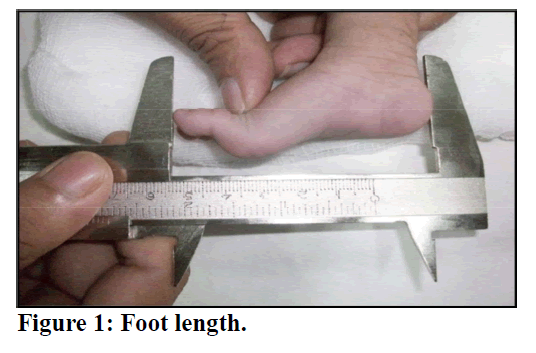
Figure 1. Foot length.
Head circumference was measured by encircling supra orbital ridges anteriorly, occipital prominence posterioly and above the ear lobes laterally. It is measured using a Flexible, non-stretchable measuring tape. Head circumference is documented in centimetres (Figure 2).
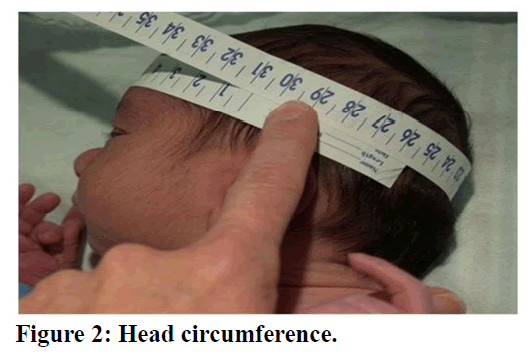
Figure 2. Head circumference.
Crown heel length was measured from head to heel in lying position and before measuring the lower limbs should be straightened out. It is measured using an infant meter and the measurements are documented in centimetres (Figure 3). Chest circumference was measured using a Flexible, non-stretchable measuring tape at the level of nipples. The measurements are documented in centimetres (Figure 4). Weight of the baby is measured using a electronic weighing machine and the measurements are documented in grams (Figure 5).
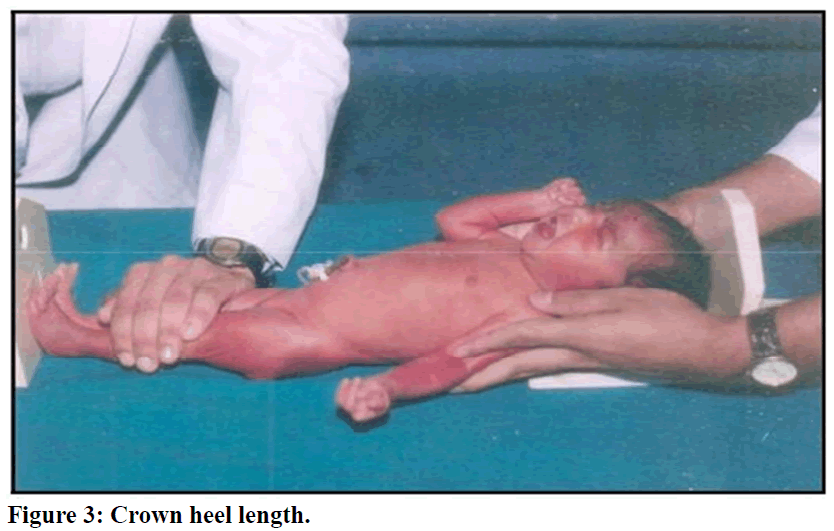
Figure 3. Crown heel length.
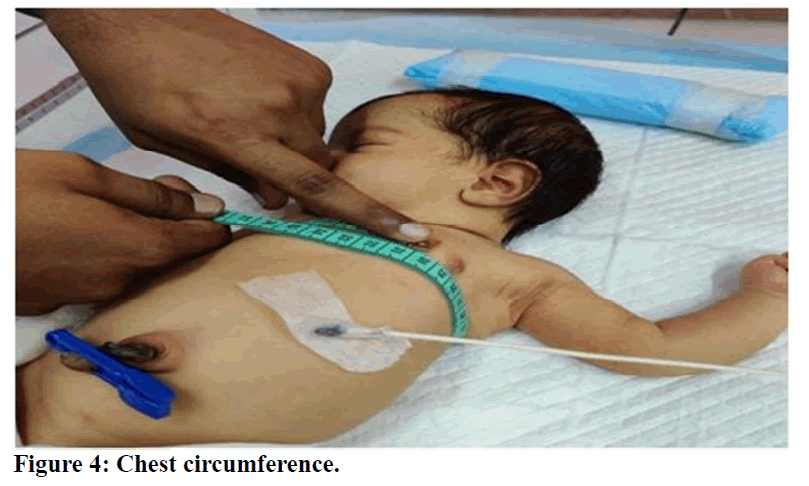
Figure 4. Chest circumference.
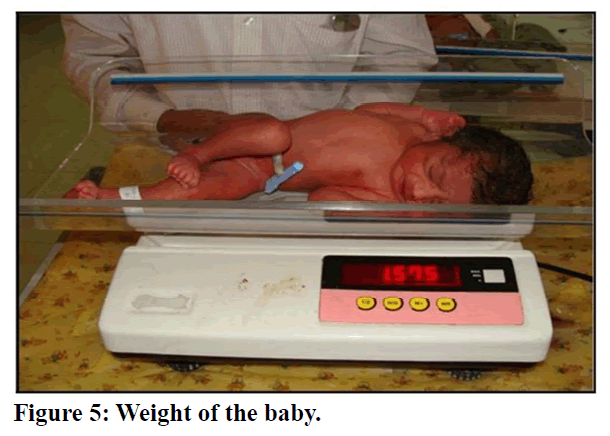
Figure 5. Weight of the baby.
Merz model which is used to determine gestational age by measuring foot length. The foot length of the baby which is measured within 24 hours of life using a vernier caliper is plotted against the Merz model to determine the gestational age of the baby (Table 1).
| Gestational age in weeks | Foot length (mm) |
|---|---|
| 24 | 44-45.9 |
| 25 | 46-48.9 |
| 26 | 49-51.9 |
| 27 | 52-53.9 |
| 28 | 54-55.9 |
| 29 | 56-58.9 |
| 30 | 59-60.9 |
| 31 | 61-63.9 |
| 32 | 64-65.9 |
| 33 | 66-68.9 |
| 34 | 69-70.9 |
| 35 | 71-72.9 |
| 36 | 73-75.9 |
| 37 | 76-77.9 |
| 38 | 78-80.9 |
| 39 | 81-82.9 |
| 40 | 83-84.9 |
| >40 | >85 |
Table 1: Merz model which is used to determine gestational age by measuring foot length.
New ballard score
Ballard's maturational assessment consists of 6 physiological and 6 neuromuscular criterias. This scoring system allows to estimate gestational age in the range of 20-44 weeks (Figure 6).
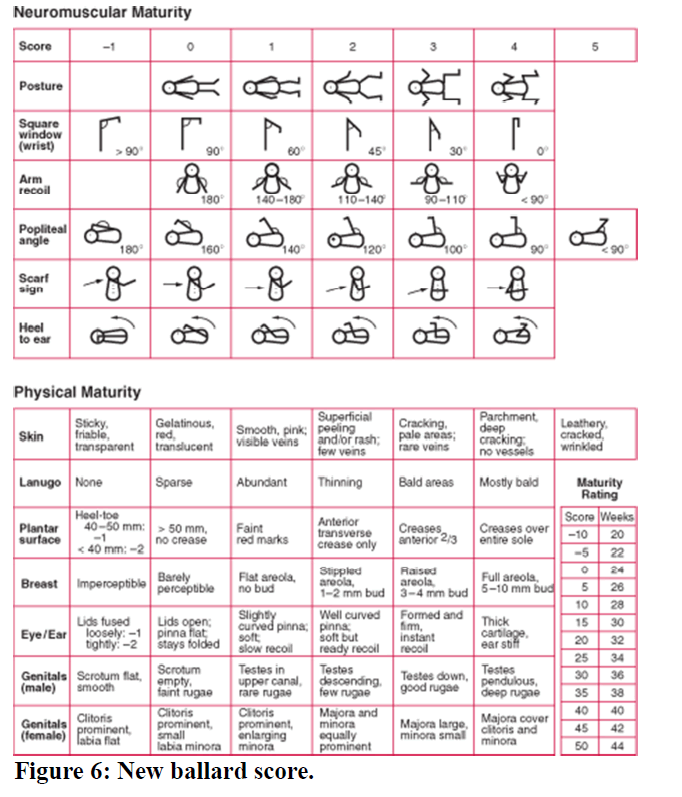
Figure 6. New ballard score.
Results
In this study out of 200 neonates 125 (62.5%) were delivered by Normal vaginal Delivery, while 57 (28.5%) of the neonates were delivered by Caesarean section and 18 (9%) of them were instrumental delivery (Table 2 and Figure 7). In this study, out of 200 patients as per revised B.G. Prasad scale 8 (4%) of them belonged to Upper class , 32 (16%) patients belonged to Upper Middle class , 49 (24.5%) belonged to Middle class, 50 (25%) patients belonged to Lower Middle Class and 61 (30.5%) patients belonged to Lower class (Table 3 and Figure 8).
| Mode of Delivery | Total number of patients | Percentage |
|---|---|---|
| NVD | 125 | 63% |
| LSCS | 57 | 28.50% |
| Instrumental | 18 | 9% |
Table 2: Mode of delivery of the babies.
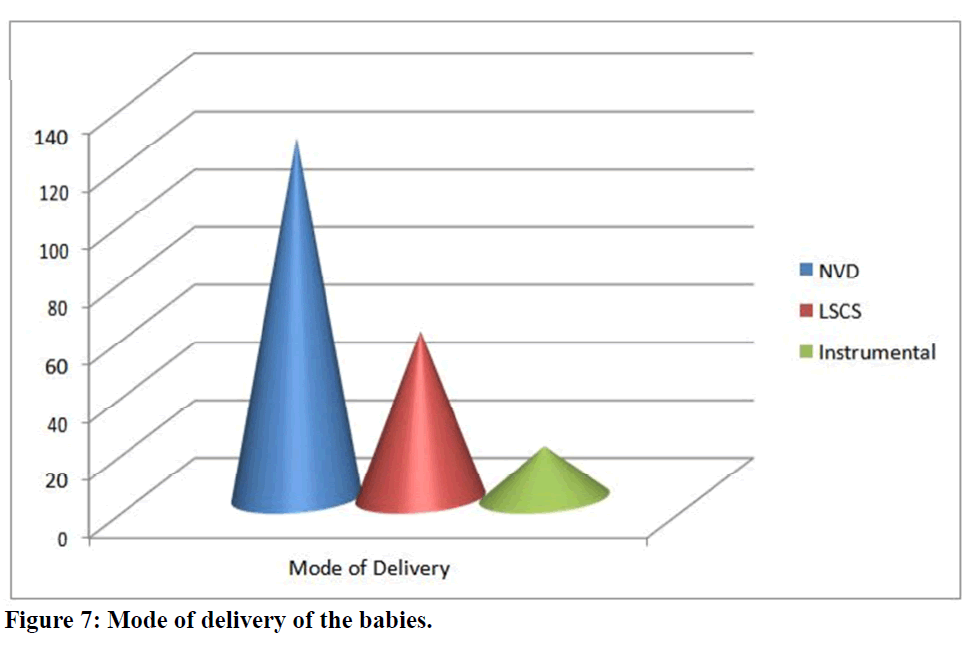
Figure 7. Mode of delivery of the babies.
| Class | Number of patients | Percentage |
|---|---|---|
| Upper Class | 8 | 4% |
| Upper Middle Class | 32 | 16% |
| Middle Class | 49 | 24.50% |
| Lower Middle Class | 50 | 25% |
| Lower Class | 61 | 30.50% |
Table 3: Socio economic Status of the Family as per B.G. Prasad scale (2019 Revised).
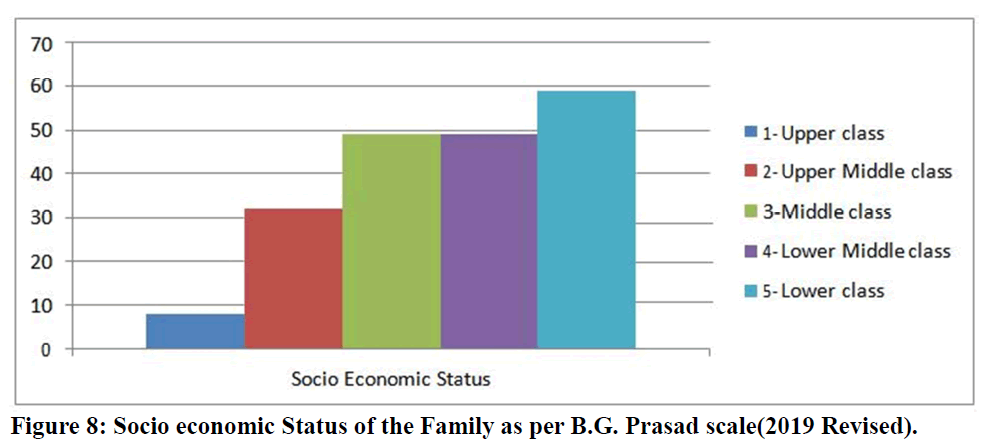
Figure 8. Socio economic Status of the Family as per B.G. Prasad scale(2019 Revised).
This study included 200 new-born babies of which 66 babies (33%) were low birth weight i.e., below 2500gms and 134 babies were above 2500gms (Table 4 and Figure 9). Out of this 200 babies 55 babies (27.5%) were preterm i.e., babies with gestational age below 37 weeks and 145 babies (72.5%) were term babies (Table 5 and Figure 10).
| Birth weight | Frequency | Percent |
|---|---|---|
| <2500 | 66 | 33 |
| >2500 | 134 | 67 |
| Total | 200 | 100 |
Table 4: Distribution of babies based on their birth weight.
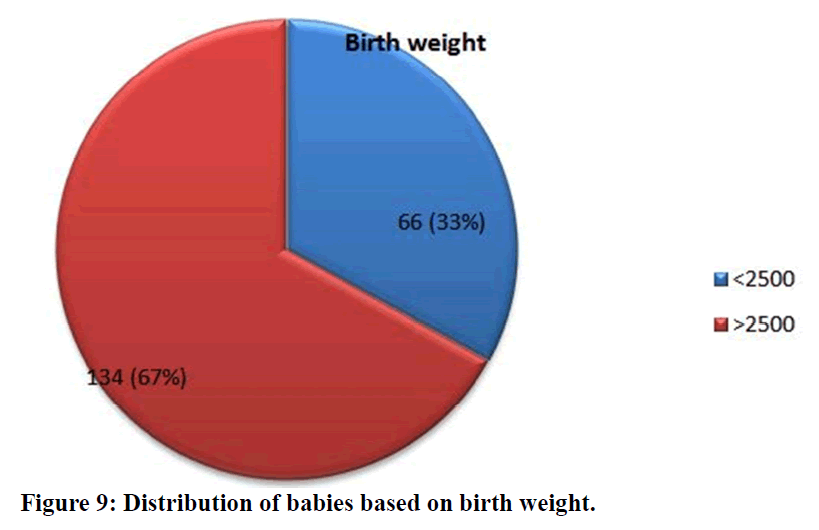
Figure 9. Distribution of babies based on birth weight.
| Term/Preterm | Frequency | Percent |
|---|---|---|
| Preterm | 55 | 27.5 |
| Term | 145 | 72.5 |
| Total | 200 | 100 |
Table 5: Distribution of babies based on their gestational age.
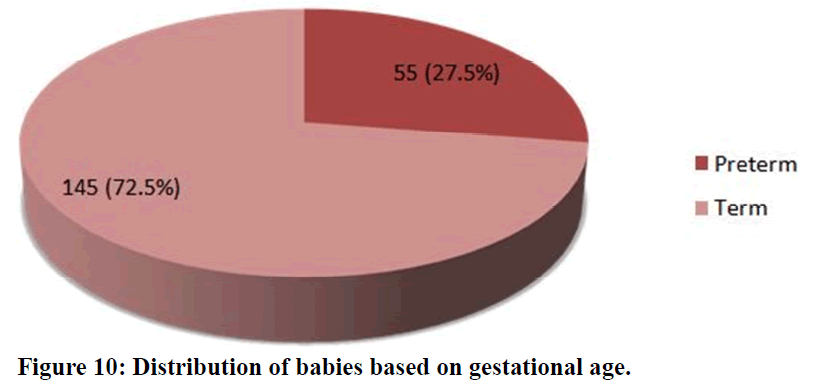
Figure 10. Distribution of babies based on gestational age.
Out of 200 new-borns 55 were preterm babies and out of that 31 babies (56.3%) were female and 24 babies (43.7%) were male (Table 6 and Figure 11).
| Sex | Number of Preterm babies | Percentage |
|---|---|---|
| Female | 31 | 56.30% |
| Male | 24 | 43.70% |
Table 6: Sex distribution of the preterm babies.
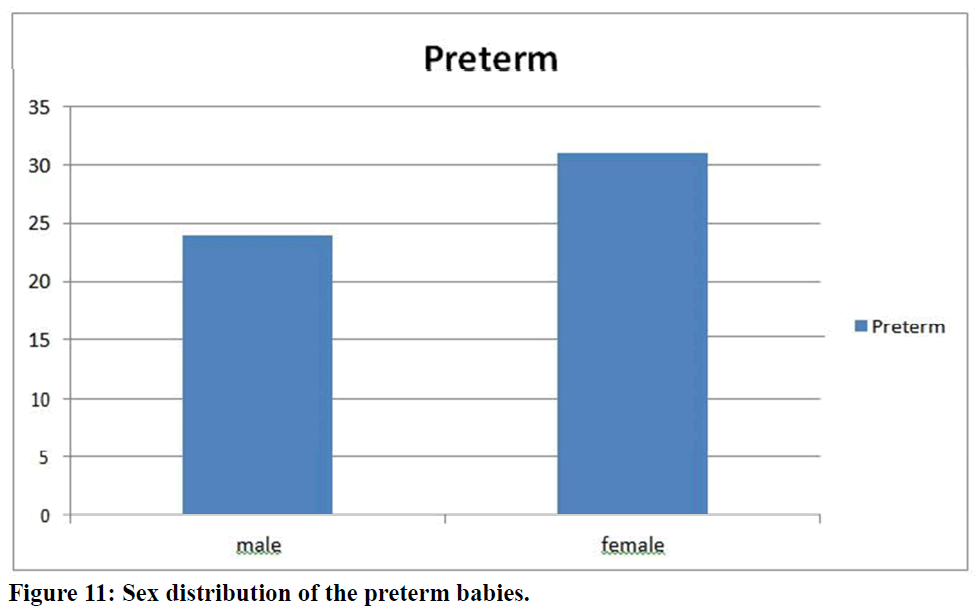
Figure 11. Sex distribution of the preterm babies.
Discussion
Early identification of gestational age and low birth weight is an important step in decreasing neonatal morbidity and mortality rate. Various anthropometric measures like chest circumference, head circumference, crown heel length, etc., have been tried to assess the gestational age and birth weight of the baby [12-16]. In developing countries like India, equipment’s are not available in primary centres and minimum handling is required to get the maximum information. In that aspect foot length can be used to determine gestational age and birth weight which requires minimum handling and can easily be measured even in a sick infant. The present study is done to find the correlation between gestational age determined by antenatal USG, New Ballard Score and foot length of the baby so that foot length can be used as proxy to determine in between April 15, 2018 to April 14, 2019. 200 new-borns who were appropriate for the gestational age of the baby. The present study was do gestational age as determined by antenatal USG were taken for this study and the foot length measurement were taken within 24 hours of life [17-19].
Out of these 200 babies 105 babies (52.5%) were female and 95 babies (47.5%) were male. This study is comparable to James et al. Study [7] which showed 59 males (48%) and 64 females (52%) out of 123 neonates studied and in all other studies male babies were predominant. 55 babies (27.5%) were preterm and 145 babies (72.5%) were term. Out of 55 preterm babies 31 babies were female and 24 babies were male. Out of 145 term babies 74 babies were female and 71 babies were male. This study is comparable to previous study which showed 17.6% preterm and 82.4% term neonates and James et al. [7] study which showed 76.4% term and 23.6% preterm neonates.66 babies (33%) were low birth weight i.e, <2499 grams irrespective of their gestational age and 134 babies (67%) were born with normal weight i.e, >2500 grams [19-22].
In a study done by Ballard et al. [23] prevalence of low birth weight was 24.6% which is comparable to present study. Out of that 200 babies gestational age range was between 26-41 weeks with a mean gestation of 36 weeks and a standard deviation of +3 weeks. Foot length of these 200 babies varied between 51 - 84 millimetres with a mean foot length of 76 mm and a standard deviation of + 7 mm. The crown heel length of these 200 babies ranged between 33.5 - 51.5 centimetres with a mean length of 45.8 cm and a standard deviation of +3.9 cm. The head circumference of these 200 babies varied between 26 - 35.5 centimetre with a mean circumference of 32.4 cm and a standard deviation of +2.4 cm. The weight of these 200 babies varied between 880 - 3410 grams with a mean weight of 2551 gram and a standard deviation of + 591gms. The gestational age which was assessed using Merz value for these 200 babies ranged between 26-41 weeks with a mean gestation of 36 weeks and standard deviation of +3 weeks [22-24].
In this study out of 200 babies the foot length of the preterm babies ranged between 51 - 75 mm with a mean length of 65mm and a standard deviation of +6 mm. The foot length of term babies varied between 75 - 84mm with a mean length of 79 mm and a standard deviation of 2mm. In a study conducted by Ballard et al. [23] showed the mean foot length of preterm as 65.6 ± 4.3 mm and of term as 76 ± 3.3 mm which is comparable with present study. A study which was done by Mhaskar et al. [19] showed the mean foot length in preterm as 71.8 ± 5.7 mm and terms as 80 ± 2.8 mm which are slightly higher than this present study.
In this study out of 200 babies the crown heel length of the preterm babies ranged between 33.5 - 45.5 cm and a mean length of 40.4 cm and a standard deviation of +3.4 cm. The crown heel length of the term babies varied between 45 - 51.5 cm and a mean length of 47.9 cm and a standard deviation of +1.1 cm. This is comparable to Neela et al. [24] study which showed mean crown heel length of term AGA as 48.36 ± 3.13 cm. James et al. [7] study also showed similar results with mean crown heel length in term AGA neonates as 51.08 ± 2.05 cm which is slightly high compared to this study. In this study out of 200 babies the weight of the preterm babies ranged between 880- 2510 grams and a mean weight of 1774 gm. and a standard deviation of + 488gms. The weight of the term babies varied between 2260- 3410 grams and a mean weight of 2846 gm and a standard deviation of + 275gms. In a previous study new-borns the mean birth weight was 2.679 kg which is comparable to present study In this study out of 200 babies the head circumference of preterm babies ranged between 24 - 32 cm and a mean circumference of 29.1 cm and a standard deviation of +2.2cm. The head circumference of term babies ranged between 31.5-35.5 cm and a mean circumference of 33.7 cm and a standard deviation of +0.8cm. James et al. [7] study showed mean head circumference for term AGA as 34.03 ± 2.88 cm which is comparable to present study In preterm babies there was significant correlation between the gestational age determined by antenatal USG and gestational age determined by measuring foot length. Pearson correlation coefficient (r value) is 0.995 and p-value is 0.0001 which shows positive correlation between both the data. In term babies the Pearson correlation coefficient (r value) is 0.959 and p-value is 0.0001 which shows positive correlation between both the data [25-27].
In preterm babies there was significant correlation between the gestational age determined by New Ballard Score and gestational age determined by measuring foot length. Pearson correlation coefficient (R-value) is 0.958 and p-value is 0.0001 which shows positive correlation between both the data. In term babies the Pearson correlation coefficient (r value) is 0.746 and p- value is 0.0001 which shows positive correlation between both the data. The studies conducted by James et al. [7] showed positive correlation between foot length and gestational age, birth weight, head circumference. But the correlation coefficient was higher between gestational age and foot length.
Conclusion
Significant correlation was noted between gestational age and foot length in this study in both preterm and term babies. Hence foot length of new-born babies measured within 24 hours of life can be plotted against Merz data to determine gestational age and it can be used as a proxy to the gestational age of the new-born. Foot length is a simple, quick and reliable anthropometric measurement which can be used as a proxy measurement to gestational age assessment and birth weight especially in sick and pre-term neonates receiving intensive care. It can be easily measured by medical practitioners and traditional birth attendants in the community.
According to this study foot length of the baby >76 mm signifies that the gestational age of the baby is more than 37 weeks and requires routine care only. When the foot length of the baby is between 70 and 75 mm, it signifies the gestational age of the baby is between 34 and 37 weeks and requires observational care. When the foot length of the baby is <70mm it signifies that the gestational age of the baby is less than 34 weeks and should to referred to higher centre for further management to prevent morbidity and mortalities associated with preterm.
Funding
No funding sources.
Ethical Approval
The study was approved by the Institutional Ethics Committee.
Conflict of Interest
The authors declare no conflict of interest.
Acknowledegements
The encouragement and support from Bharath University, Chennai is gratefully acknowledged. For provided the laboratory facilities to carry out the research work.
References
- https://www.collinsdictionary.com/
- American academy of pediatrics committee on fetus and newborn. Nomenclature for duration of gestation, birth weight and intra-uterine growth. Pediatrics 1967; 39:935-9.
- https://childmortality.org/
- Kliegman RM. The fetus and the neonatal infant: Prematurity and intrauterine growth retardation. In Berhman RE, Vaughan VC, Nelson WE (Edn). Nelson textbook of paediatrics, 15th Edn. Philadelphia, WB Saunders, 1996; 431– 513.
- https://apps.who.int/iris/handle/10665/37003
- Dubowitz LMS, Dubowitz D, Goldberg C. Clinical assessment of gestational age in the newborn infant. J Paediatr 1970;77:1-10.
- James DK, Dryburgh EH, Chiswick ML. Foot length–a new and potentially useful measurement in the neonate. Archives Dis Childhood 1979; 54:226-30.
- Bhatia BD, Tyagi NK. Birth weight: Relationship with other fetal anthropometric parameters. Indian Pediatr 1984; 21:833-8.
- Mathur A, Tak SK, Kothari P. Foot length–a newer approach in neonatal anthropometry. J Tropical Paediatr 1984; 30:333-6.
- Hern WM. Correlation of fetal age and measurements between 10 and 26 weeks of gestation. Obstetr Gynecol 1984; 63:26-32.
- Bhargava SK, Ramji S, Kumar A, et al. Mid-arm and chest circumference at birth as predictors of low birth weight and neonatal mortality in the community. Br Med J 1985; 291:1617-9.
- Daga SR, Daga AS, Patole S, et al. Foot length measurement from foot print for identifying a newborn at risk. J Tropical Pediatr 1988; 34:16-19.
- Daga SR, Daga AS, Dighole RV, et al. Rural neonatal care: Dahanu experience. Indian Pediatr 1992; 29:189-93.
- Daga SR, Daga AS, Dighole RV, et al. Anganwadi worker’s participation in rural newborn care. Indian J Pediatr 1993; 60:627-30.
- Mercer BM, Sklar S, Shariatmadar A, et al. Fetal foot length as a predictor of gestational age. Am J Obstetr Gynecol 1987; 156:350-5.
- Goldstein I, Reece A, Hobbins JC. Sonographic appearance of the fetal heel ossification centers and foot length measurements provide independent markers for gestational age estimation. Am J Obstetr Gynaecol 1988; 159:923-7.
- Sharma JN, Saxena S, Sharma U. Relationship between birth weight and other neonatal anthropometric parameters. Indian Pediatr 1988; 25:244-8.
- Platt LD, Medearis AL, DeVore GR, et al. Fetal foot length: Relationship to menstrual age and fetal measurements in the second trimester. Obstetr Gynaecol 1988; 71:526-31.
- Mhaskar R, Agarwal N, Takkar D, et al. Fetal foot length–a new parameter for assessment of gestational age. Int J Gynaecol Obstetr 1989; 29:35-8.
- Madhulika, Kabra SK, Barar V, et al. Upper and lower limb standards in newborn. Indian Pediatr 1989; 26:667-70.
- Dusitsin N, Chompootaweep S, Poomsuwan P, et al. Development and validation of a simple device to estimate birth weight and screen for low birth weight in developing countries. Am J Public Health 1991; 81:1201-5.
- Huque F, Hussain AMZ. Detection of low birth weight newborn babies by anthropometric measurements in Bangladesh. Indian J Paediatr 1991; 58:223-31.
- Ballard JL, Khoury JC, Wedig K, et al. New ballard score, expanded to include extremely premature infants. J Paediatr 1991; 119:417-23.
- Neela J, Raman L, Balakrishna N, et al. Usefulness of calf circumference as a measure for screening low birth weight infants. Indian Paediatr 1991; 28:881-4.
- Kustermann A, Zorzoli A, Spagnolo D, et al. Transvaginal sonography for fetal measurement in early pregnancy. Br J Obstetr Gynaecol 1992; 99:38-42.
- Gohil JR, Sosi M, Vani SN, et al. Foot length measurement in the neonate. Indian J Pediatr 1991; 58:675-7.
- Amato M, Huppi P, Claus R. Rapid biometric assessment of gestational age in very low birth weight infants. J Perinatal Med 1991; 19:367-71.
Author Info
Selvendran C, Jagadeeswari S and S Sundari*
Department of Orthopaedics, Sree Balaji Medical College & Hospital Affiliated to Bharath Institute of Higher Education and Research, IndiaCitation: Selvendran C, Jagadeeswari S, S Sundari, Assessment of Gestational Age by Measuring Postnatal Foot Length of the Infant, J Res Med Dent Sci, 2021, 9(6): 294-305
Received: 30-Mar-2021 Accepted: 23-Jun-2021 Published: 30-Jun-2021
